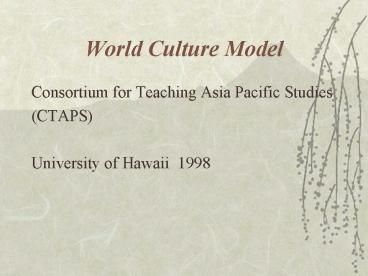World Culture Model PowerPoint PPT Presentation
1 / 16
Title: World Culture Model
1
World Culture Model
- Consortium for Teaching Asia Pacific Studies
- (CTAPS)
- University of Hawaii 1998
2
World Culture Model defining culture
- A pattern of behaviour that is shared by a group
(sometimes defined by national borders, but more
often by a shared geographical or historical
experience). - It consists of learned ways of thinking and
acting, common to all people, which distinguishes
them from other people. The products of culture
such as clothing, art works, and social
institutions, reflect the culture.
3
Why address culture?
- interdependent world/ global world, students of
the 21st Century need an understanding of the
societies that populate the world in order that
they may interact with them more effectively.
Socially, politically and economically societies
have become irreversibly interconnected. - citizens of the 21st Century need the skills to
understand the concept of culture, to analyse the
components, which make it up, and to interpret
its meaning for them personally and for the world
at large.
4
HISTORICAL CONTEXTPast Present
Future
Social
Political
Values and Beliefs
Values and Beliefs
Economic
Aesthetic
GEOGRAPHICAL CONTEXT Location
Human/Environment Interaction Region Place
Movement
5
A framework
- The World Culture Model can provide such
framework. The model is not a flowchart and it is
not an outline of content to be covered. - However, the model does provide a general picture
of the important issues and concepts that should
be included in any cultural study (in order that
none be overlooked) - change vs stability
- interdependence
- communication and conflict.
6
One or Many
- A teacher may choose to study one culture in
depth - Japan for example. In this case each one
of the thematic bubbles would be included in the
study through a variety of activities that would,
when possible, consider the general issues of
change Vs stability, interdependence,
communication and conflict as they apply to the
five themes, with historical and geographical
studies being brought in as necessary.
7
Comparative Study
- Or a teacher may wish to select one of the
cultural universals - economics for example - and
use it as a basis for a comparative study of
several different cultures, again focussing upon
the general background issues as much as
possible. - Venn Diagram
8
Historical Context
- Discovery
- Wars
- Leaders
- Exploration
- Indigenous peoples
9
Geographical Context
- Islands
- Region
- Bodies of water
- Unique features
- Natural disasters
10
Values and Beliefs
- Religions
- Church
- Shrines
11
Social
- Clothing
- Food
- Entertainment
- Language
- Houses
- Social roles
- Education
- Hobbies
- Sport
- Festivals
12
Political
- System of government
- Parliament
- Flag
- National symbols
- National Anthem
- War
- Map
- Constitution
- Population
13
Economic
- Money
- Trade imports
- and exports
- Business
- Agriculture
14
Aesthetic
- Clothing
- Art
- Buildings
- Theatre
- Opera
- Craft
- Film
15
Implementation
- It is always important to have clear structure
and specific goals in mind. - Ensure all lessons are relevant and applicable.
Otherwise there is the danger of merely teaching
a series of entertaining, but unrelated
activities which do not advance the students
understanding of fundamental cultural issues. - Rich, Real and Relevant
16
HISTORICAL CONTEXTPast
Present
FutureHiroshima
Immigration
Social
Political
JAPAN
Values and Beliefs
Values and Beliefs
Economic
Aesthetic
GEOGRAPHICAL CONTEXT Location
Human/Environment Interaction Region North
Pacific Ocean Rice Fields Oriental 4 main
islands Place Movement
Islands, Mt Fuji, Cherry Blossom Cars,
Computers, Electronic equipment

